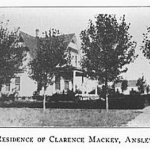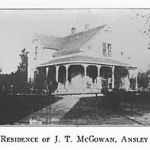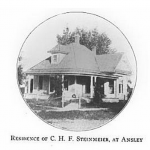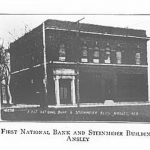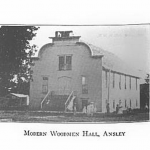ANSLEY
Ansley is an enterprising town of 1,000 population, located in the southeastern part of Custer county, on the main line of the Chicago, Burlington & Quincy Railroad to the north west. The county around it is adapted to farming and stock-raising and these are the chief occupations of the people. The first settlement was made in the year 1886, in which year the Lincoln Land Company purchased from Anthony Wilkinson, a ranchman, the land upon which the town now stands, and platted the town, naming it in honor of a lady by the name of Ansley who had invested considerable money in real estate here. The first frame building erected was occupied by a lawyer by the name of George Snell. The second building was the store building of Edgar Varney, which he moved over from Westerville. These structures were soon followed by others, among them the Van Sant House, later known as the Commercial hotel, the drug store of Sam Royds, two bank buildings, the stores of E. H. Burrows and A. H. Shepard and the Eureka hotel. The private residences of E. H. Gaines and Dan Hagin were erected in 1887 and that of C. J. Stevens in 1888.
- Residence of Clarence Mackey, Ansley, Nebraska
- Residence of J. T. McGowan, Ansley, Nebraska
- Residence of C. H. F. Steinmeier, Ansley, Nebraska
- First National Bank and Steinmeier Building, Ansley, Nebraska
- Modern Woodmen Hall, Ansley, Nebraska
Among the first citizens of Ansley may be mentioned A. H. Turpen, O. P. Allphin, Mrs. H. Stevenson, C. J. Stevens, Edgar Vamey, Dan Hagin, E. H. Gaines, E. H. Burrows, D. A. Van Sant, Sam Royds, Thomas Blowers, A. H. Shepard, C. M. Dorr, James Davis, F. E. Gosselin, and A. L. and E. A. Butler, to whose enterprise and business judgment in those early times are largely due the later progress and prosperity of this community. Mr. E. H. Burrows, one of the old citizens, describes his first visit to Ansley in these words: “I first struck the town in the middle of May, 1886. At that time, there was a tent and a wagon-load of lumber to mark the spot where the future metropolis of the southeastern part of Custer county was to be. I selected my lot for a building site at that time and went back east for a while, to await developments, re turning about the 7th of July. On my return, I found more tents and more lumber on the ground, and a few shanties in the course of erection. We were compelled to haul our lumber for building purposes by wagon from Kearney, over sixty miles, which brought the price of six-dollar-a-thousand knot-holes up to the price of ‘B’ select. While staying at Ansley this time, I boarded at the West End hotel, a fine structure built of ‘B’ select, with kitchen, dining room, office, parlor, bathroom, and bedroom combined. Everybody was good natured and the landlord expected his guests to ‘double up’ every night with whoever he saw fit to assign us, and at the first peep o’ day the clerk would come and shake us, saying, ‘Time to roll off them tables; the girls want to set the tables for breakfast,’ with which request we cheerfully complied, pulling on our shoes as quickly as possible, going out of doors and leaning up against the knot-holes until the bell rang for breakfast, when we sat up to the table. The waiter then called out from the kitchen, ‘Tea or coffee, which? you fellows on the north end.’ Of course we said ‘coffee’ because it had more body than tea, which prevented us from seeing what was floating about between the bottom and top of the cup. The waiter brought in a plate of hot biscuits and another with eggs and bacon, set them on the table and said, ‘Now, boys, help yourselves.’ We waited for some time, wondering if we were expected to use our hands for plates and our fingers for knives and forks. We finally asked the waiter if that was the intention. He replied, ‘Come off the dump! Shoo! Shoo! Shoo! There is your tableware.’ And sure enough there it was. We had failed to remove the cover of fat. saucy flies that had taken possession of our plates as if they had Expected to be waited upon first. Such was my first experience with Ansley. When I arrived a third time, after an absence of four or five weeks, I found that a great change had been made—from a brown prairie to a busy village. I found about twenty buildings, in different stages of erection, my own among them, which was partly inclosed. I scraped a lot of shavings together, spread down my blankets and slept under my own vine and fig tree. But, alas! not alone. After I fell asleep, I dreamed I was a boy again and went down to the creek to take a swim, and just as I was ready to take a plunge into the water, I fell backwards into a bunch of nettles. I awoke, and as soon as I got myself located, I realized that it was not nettles, but fleas.”
The railroad was put through Ansley in the fall of 1886. Mr. Fred Gosselin was the first operator. The putting of the railroad through not only brought Americans, but also folks from across the seas to share in the bounties of this western country. One of these, Mrs. Anna Thessen, in a letter from Mason City addressed to Mr. E. P. Gaines and dated June 16, 1918, tells of her first visit to Ansley:
“As I read the question in your advertisement, I thought that I would send in a few items. It is thirty years ago, the 21st of this month, that I, a young girl of seventeen, fresh from Germany, came to Ansley. As I couldn’t talk American, I did the next best thing and got an English—German dictionary, in which I looked up such words as ‘hotel,’ breakfast,’ ‘how much,’ ‘coffee,’ ‘tea,’ ‘team,’ ‘livery barn.’ and so on, and that way found the hotel, asked for breakfast, paid for it, hired a team and was taken to the farm of John Graf. The hotel was called the ‘Cottage Hotel’ and was kept by either Mrs. Van Sant or Mrs. Alex Moore; anyhow it was one of the two. The livery barn was kept by Ed. Sloan and was standing west of Harry McNulty’s restaurant. I also bought candy at Edgar Varney’s store. The bank, I think, was run at that time by C. J. Stevens.”
The motto of Ansley is: “Push, that’s Ansley,” and the enterprise and thrift of its business men have proved its proper applicability. They are, and have generally been, men of unselfish service, broad vision, and community pride—men whose aim is, and has been, to serve the community as well as themselves. And whatever this town may become, it will owe much to those sturdy pioneers who, in defiance of hail, hot winds, and drouth, blazed the trail that others have followed to success and opulence.
Credits
History of Custer County, Nebraska, A Narrative of the Past, with special emphasis upon the pioneer period of the county’s history, its social, commercial, educational, religious and civic development from the early days to the present time.
William Levi Gaston, A. R. Humphrey
Copyright, 1919 by Western Publishing & Engraving Co.

